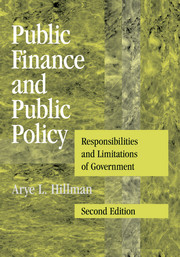Book contents
- Frontmatter
- Contents
- Preface to the Second Edition
- 1 MARKETS AND GOVERNMENTS
- 2 INSTITUTIONS AND GOVERNANCE
- 3 PUBLIC GOODS
- 4 PUBLIC FINANCE FOR PUBLIC GOODS
- 5 MARKET CORRECTIONS
- 6 VOTING
- 7 SOCIAL JUSTICE
- 8 ENTITLEMENTS
- 9 CHOICE OF TAXATION
- 10 THE NEED FOR GOVERNMENT
- TOPICS FOR DISCUSSION
- Author Index
- Subject Index
- References
7 - SOCIAL JUSTICE
- Frontmatter
- Contents
- Preface to the Second Edition
- 1 MARKETS AND GOVERNMENTS
- 2 INSTITUTIONS AND GOVERNANCE
- 3 PUBLIC GOODS
- 4 PUBLIC FINANCE FOR PUBLIC GOODS
- 5 MARKET CORRECTIONS
- 6 VOTING
- 7 SOCIAL JUSTICE
- 8 ENTITLEMENTS
- 9 CHOICE OF TAXATION
- 10 THE NEED FOR GOVERNMENT
- TOPICS FOR DISCUSSION
- Author Index
- Subject Index
- References
Summary
We shall now study social justice. We have seen that, unless the rich and the poor form a coalition against the middle, self-interested majority voting is predicted to result in income transfers that benefit the median voter. Director's law indicates that the middle class, of which we expect the median voter in high-income democracies to be part, disproportionately benefits from publicly financed public goods – and the middle class also benefits from tax deductions. Nonetheless, in high-income democracies, the beneficiaries of income redistribution are not the middle class but rather low-income people. The evidence, which was indicated in the previous chapter, therefore does not verify the prediction that the median voter or middle class will use majority voting for personal benefit through income transfers. Rather, in high-income democracies, redistribution of income is consistent with the conception of social justice that people who have not fared well in life should be helped.
However, the taxes paid to finance the income transfers to low-income people are compulsory. The taxes and income transfers contradict Pareto efficiency (taxpayers lose and recipients of income transfers gain) and are contrary to the principle of the natural right of possession of people to their own income. We confront, therefore, the normative question:
How are involuntary income transfers justified?
We shall address this question on the supposition that governments can identify who is effectively paying taxes and bears the burden of taxation, and who benefits from the redistribution of tax revenue, given (as we saw in chapter 4) that legal and effective incidence of taxes and subsidies generally differ.
- Type
- Chapter
- Information
- Public Finance and Public PolicyResponsibilities and Limitations of Government, pp. 489 - 586Publisher: Cambridge University PressPrint publication year: 2009



